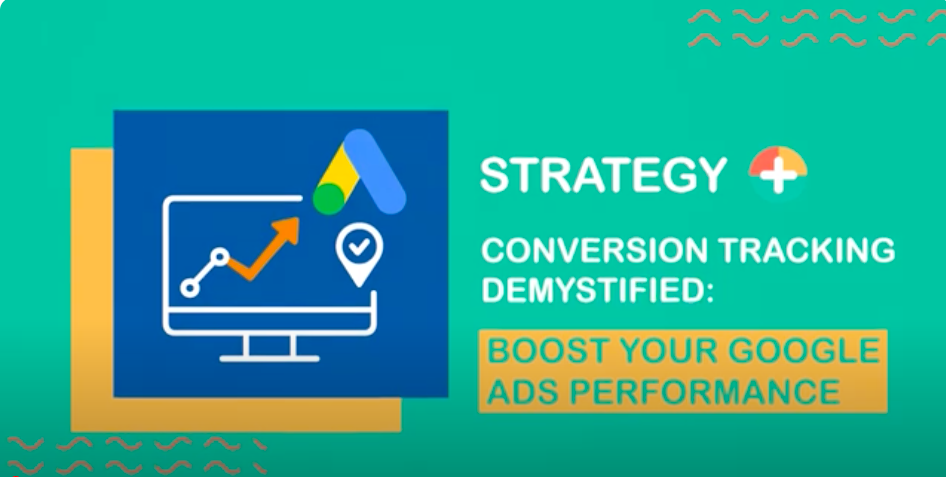
Welcome to this month’s Strategy Plus insights blog!
In our latest video, I (Dan) sat down with our PPC specialist, Emma, to unpack one of the most important—but often misunderstood—elements of Google Ads: conversion tracking.
If you’re currently running Google Ads or thinking about diving in, this blog will help you understand what conversions are, why they’re crucial, and how to make sure your campaigns are set up for success.
 What Is a Conversion?
What Is a Conversion?
In simple terms, a conversion is any valuable action you want a user to take on your website. It’s the goal you’re working toward with your Google Ads.
For lead generation businesses, conversions typically include:
- A form submission
- A phone call
- A document download
- An email click
For eCommerce, it’s usually:
- A completed purchase
- A newsletter signup e.g. 10% off your first purchase
You can also track conversions directly in Google Ads—for example, from form fills in extensions or phone calls made straight from the ad. However, these tend to be lower quality and more susceptible to spam, which is why we usually recommend sending traffic to your website, where leads can be better qualified.
Why Is Conversion Tracking So Important?
Conversion tracking is the engine behind Google Ads’ smart bidding strategies, such as Maximise Conversions and Maximise Conversion Value. Without it, Google has no idea what’s working. It can’t optimise your campaigns, and you risk wasting budget on traffic that doesn’t convert.
Once you’ve set up conversion tracking properly, Google can start learning from your data, spotting patterns, understanding which users are more likely to convert, and adjusting bidding accordingly.
In the early days, manual cost-per-click (CPC) bidding was standard. But now, with AI-driven optimisation, it’s all about cost per conversion and return on ad spend (ROAS).
How Should You Measure Success?
For Lead Generation:
Let’s say you convert one in three leads, and you’re happy to spend £300 to win a client. That means your target cost per conversion should be less than £100.
For eCommerce:
Track your ROAS. If you spend £1,000 on ads, you ideally want to generate £4,000–£5,000 in sales to cover product costs, ad spend, and leave room for profit.
Primary vs Secondary Conversions
Google lets you set primary conversions (used for optimisation) and secondary conversions (used for analysis and reporting).
For example:
- Primary: Form submissions
- Secondary: Phone number clicks, key page views, or visits to the checkout
Secondary conversions are valuable diagnostic tools. If people are reaching your checkout page but not completing the purchase, the issue might not be your ad, it could be pricing, payment options, or user experience.
How to Set Up Conversion Tracking
Tools You’ll Need:
- Google Analytics 4 (GA4)
- Google Tag Manager (GTM)
- A Consent Management Platform (e.g. Termly)
You can track user events in GA4 and promote key ones to “conversions.” On platforms like Shopify or WordPress, this is relatively straightforward.
For deeper insight, GTM allows you to track:
- Page views
- Button clicks
- Form submissions
These can then be imported into GA4 and synced with Google Ads.
Don’t Forget Consent Mode & GDPR
Thanks to GDPR (and now Consent Mode v2), users must opt in before you can track them. If they don’t accept cookies, you could lose up to 30–40% of your tracking data.
To fill in the gaps, Google uses AI and historical data to model conversions, but this works best for accounts with higher daily spend (typically several hundred pounds a day).
To stay compliant and maximise data:
- Use a Google-approved consent banner (we recommend Termly, around £16/month)
- Optimise banner design to boost consent rates (aim for 70–80% opt-ins)
But What If the Leads Aren’t Good?
Sometimes, your tracking might show strong results, but you’re still getting poor quality leads. Here’s how to diagnose the issue:
- Review your search terms: Are people searching for the services you actually offer?
- Check your ad copy: Responsive Search Ads mix headlines, make sure your messaging speaks to the right audience.
- Improve your forms: Add filters or qualifying questions to weed out time-wasters or spam.
- Segment lead sources: Use tools like WhatConverts or create unique landing pages for different channels to pinpoint where your best leads are coming from.
With tools like WhatConverts, you can:
- Score lead quality
- Assign values to conversions
- Feed that data back into Google Ads for smarter optimisation
Final Thoughts
Getting conversion tracking right is foundational to making Google Ads work for your business. From defining your goals to properly setting up your tools, tracking what matters, and optimising for real results, this is how you turn ad spend into actual growth.
Key Takeaways
✅ Clearly define your conversions
✅ Set up GA4, GTM, and Consent Mode properly
✅ Use primary conversions for bidding, secondary ones for insight
✅ Continuously review lead quality
✅ Consider tools like WhatConverts or channel-specific forms
Need help? Our PPC team at Strategy Plus is here to support you every step of the way.
📹 Watch the full video with Emma for deeper insights, and keep an eye out for our next PPC instalment.
Got questions? We’d love to talk strategy. Drop us a message to find out how we can help with your Google Ads.

